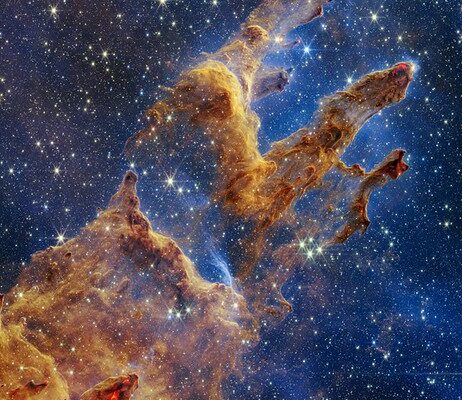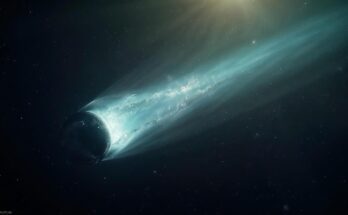The Pillars of Creation are a striking and iconic image captured by the Hubble Space Telescope in 1995. The photograph, which depicts a region of the Eagle Nebula located about 6,500 light-years away from Earth, shows three massive pillars of gas and dust that are being shaped and sculpted by the intense radiation and winds from a cluster of young, hot stars located at the center of the nebula.
The Pillars of Creation are named for their appearance, which resembles three massive pillars supporting a celestial structure. Each pillar is approximately 20 light-years long and is composed of cold molecular hydrogen and dust, which are the building blocks of stars and planets. The pillars are being subjected to intense radiation and winds from the young stars at the center of the nebula, which are causing the gas and dust to heat up and glow, creating the stunning and colorful appearance of the pillars.
The Pillars of Creation are located in the Eagle Nebula, which is also known as Messier 16 or M16. The nebula is a vast cloud of gas and dust that is located in the constellation Serpens, and is home to a number of young, hot stars that are in the process of forming. The Eagle Nebula is a region of active star formation, and the Pillars of Creation are just one small part of this larger process.
The Pillars of Creation are a beautiful and awe-inspiring sight, and they have captured the imagination of people around the world. In addition to their stunning appearance, the pillars also have scientific significance, as they provide valuable insights into the process of star formation and the evolution of the universe.
The pillars are thought to be in the early stages of the star formation process, and it is believed that they will eventually collapse under their own weight to form new stars. This process is known as gravitational collapse, and it is the driving force behind the birth of new stars in the universe. The Pillars of Creation provide a unique window into this process, allowing astronomers to study the early stages of star formation in unprecedented detail.
In addition to their scientific significance, the Pillars of Creation are also a symbol of the power and beauty of the universe. They are a testament to the vastness and complexity of the cosmos, and they remind us of our place in the grand scheme of things. Whether you are an astronomer or simply someone who is fascinated by the wonders of the universe, the Pillars of Creation are a sight that is not to be missed.
The pillars in the photograph are vast clouds of gas and dust, known as molecular clouds, that are in the process of forming new stars. The gas and dust in these clouds is being held together by the gravitational force of the stars that are already present in the region. The intense radiation and winds emanating from these stars are carving out vast cavities in the clouds, creating the distinctive pillar-like shapes that give the region its name.
The photograph of the Pillars of Creation was taken using the Wide Field and Planetary Camera 2 (WFPC2) aboard the Hubble Space Telescope. The WFPC2 is a specialized camera that is designed to capture high-resolution images of distant objects in space. It uses a series of filters to capture images in different wavelengths of light, allowing astronomers to study the composition and properties of celestial objects in great detail.
The photograph of the Pillars of Creation is actually a composite image, made up of multiple exposures taken in different wavelengths of light. These exposures were combined to create a single image that reveals the full extent of the region in all of its glorious detail.
One of the most striking features of the Pillars of Creation is the intricate network of filaments and structures that can be seen within the clouds. These structures are created by the movement and interaction of the gases and dust within the clouds, and they provide a unique window into the processes that are taking place within the nebula.
In addition to the pillars themselves, the photograph of the Pillars of Creation also reveals a number of other interesting features. For example, the bright blue regions in the image are areas where new stars are forming, while the red regions are areas where the radiation and winds emanating from the stars are heating and ionizing the gas and dust.
The Pillars of Creation photograph has inspired many people with its beauty and majesty, and it has become one of the most iconic and widely recognized images in the history of astronomy. It is a testament to the incredible capabilities of the Hubble Space Telescope, and a reminder of the vast and awe-inspiring universe that surrounds us.
Image Credit: NASA, ESA, CSA, STScI




